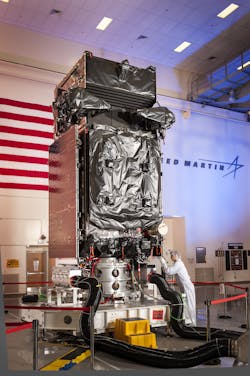Lockheed Martin, Northrop Grumman, United Launch Alliance, and Air Force Space Command launch infrared surveillance satellite
CAPE CANAVERAL AIR FORCE STATION, Fla., 26 March 2013. The U.S. Air Force’s second Space Based Infrared System (SBIRS) Geosynchronous Earth Orbit (GEO-2) spacecraft, built by Lockheed Martin (NYSE:LMT), was launched from Cape Canaveral Air Force Station, Fla., aboard a United Launch Alliance Atlas V rocket.
The SBIRS program delivers missile warning and infrared surveillance information to the President of the United States, the Secretary of Defense, combatant commanders, the intelligence community and other key decision makers. The system enhances global missile launch detection capability, supports the nation's ballistic missile defense system, expands the country’s technical intelligence gathering capacity and bolsters situational awareness for warfighters on the battlefield.
"We are proud to partner with the U.S. Air Force on the SBIRS program to deliver highly reliable infrared surveillance capabilities for strategic and tactical users across the defense and intelligence community,” explains Jeff Smith, Lockheed Martin's vice president of Lockheed Martin’s Overhead Persistent Infrared (OPIR) mission area. “Thanks to the unmatched expertise of the entire government and industry SBIRS team, we are confident this satellite will meet or exceed expectations and play a pivotal role in our national security for years to come.”
The SBIRS architecture includes a mix of satellites in geosynchronous orbit, hosted payloads in highly elliptical earth (HEO) orbit, and ground hardware and software.
The first two GEO satellites and HEO payloads have now launched.
SBIRS GEO-2 includes sophisticated scanning and staring sensors that will deliver improved infrared sensitivity and a reduction in area revisit times over the current constellation. The scanning sensor will provide a wide area surveillance of missile launches and natural phenomena across the earth; the staring sensor will observe smaller areas of interest with superior sensitivity.
"Today's successful launch of the GEO-2 satellite marks another milestone in the evolution of infrared surveillance from space," affirms Dr. Stephen Toner, Northrop Grumman's vice president of the Military and Civil Space business area. "The team played a significant role ensuring that the sensors on GEO-1 are performing beyond specification, and we are confident that the GEO-2 sensors will exhibit similar performance."
The SBIRS team is led by the Infrared Space Systems Directorate at the U.S. Air Force Space and Missile Systems Center.
Lockheed Martin is the SBIRS prime contractor. Northrop Grumman is the payload integrator. Air Force Space Command operates the SBIRS system.
Lockheed Martin’s SBIRS contracts include four HEO payloads, four GEO satellites, and ground assets to receive, process, and disseminate the infrared mission data. The team has begun initial work on the fifth and sixth GEO satellites.
